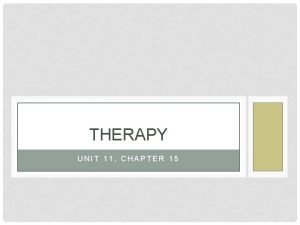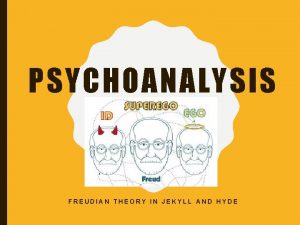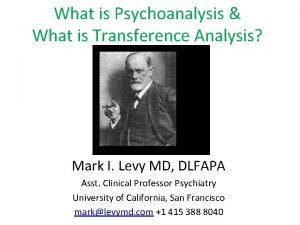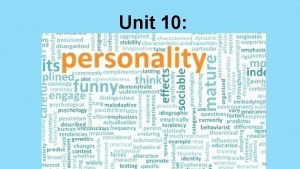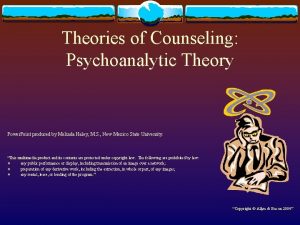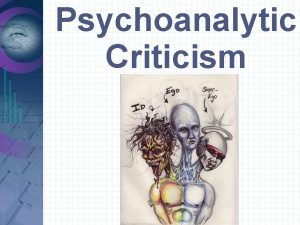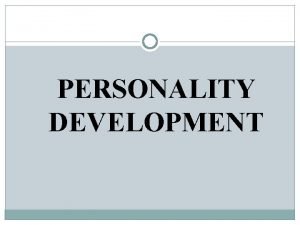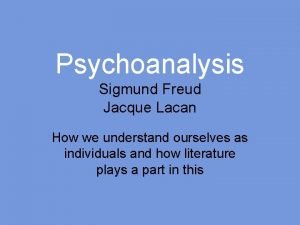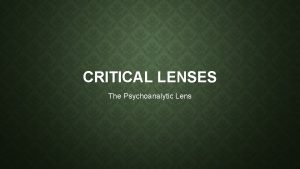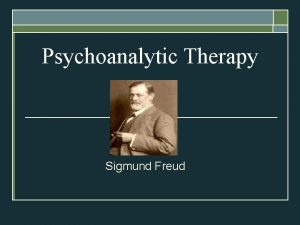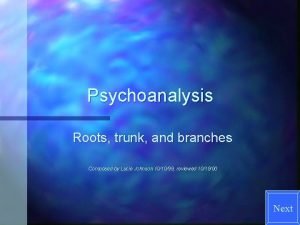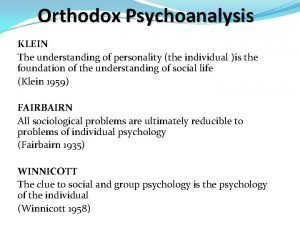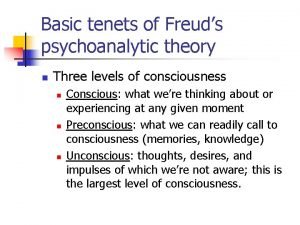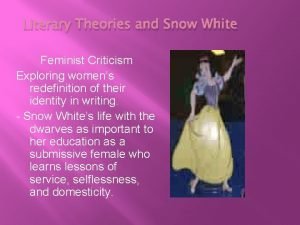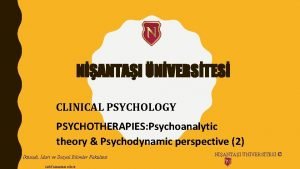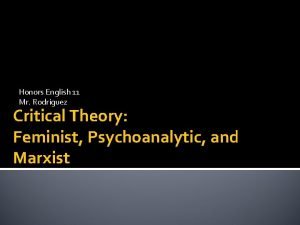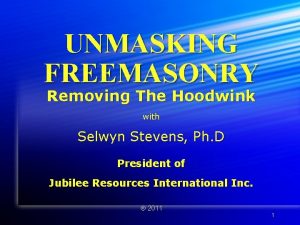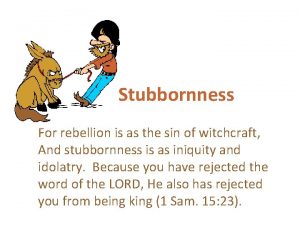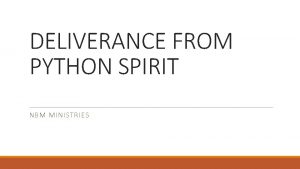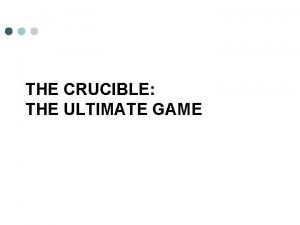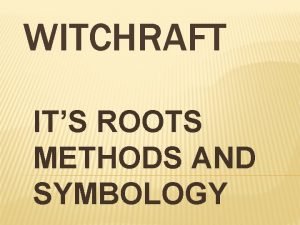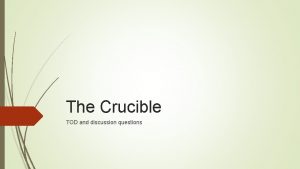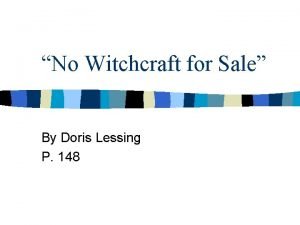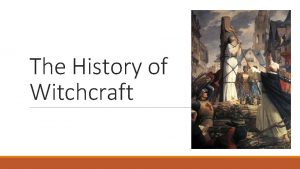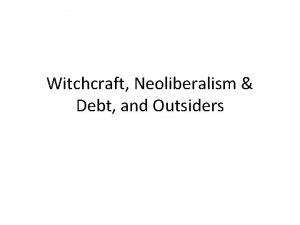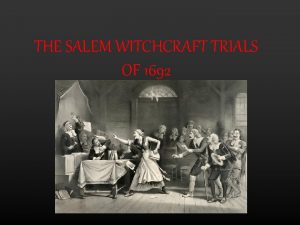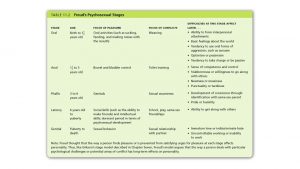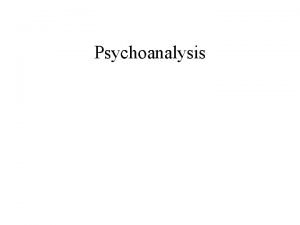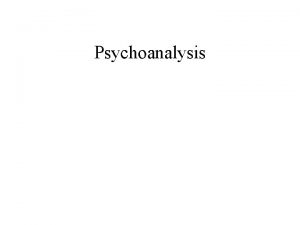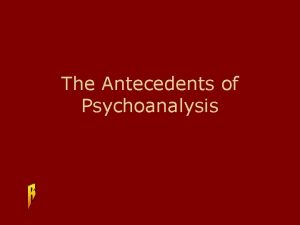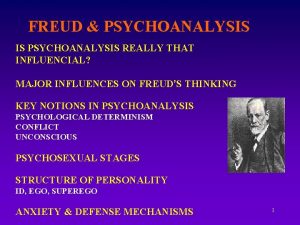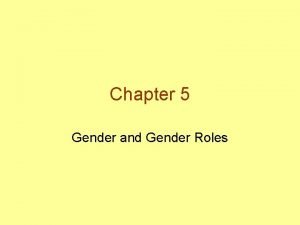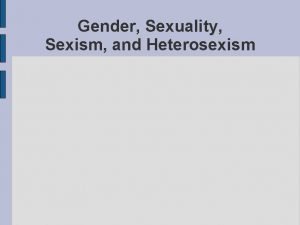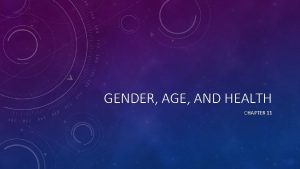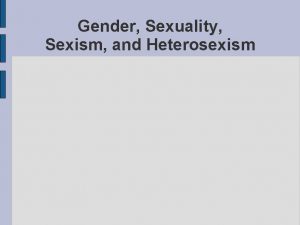Science witchcraft psychoanalysis and gender Science and gender


































- Slides: 34

Science, witchcraft, psychoanalysis and gender

Science and gender Our ideas of (modern) science: reflect gendered assumptions - gender studies brings new knowledge about very diverse fields) - gender studies is not only about women/femininity)

The gendering of science ► ‘Science ► 1. is masculine’ ‘Most scientists are male’ ► 2. ‘The problems of science are ‘masculine’’ ► 3. ‘The very idea of science is masculine’

The gendering of science ► More general critique of science ► Undoing the myth of objectivity, neutrality: production of ‘knowledge’ ► Serving power, domination, war, industry, neglecting spirituality ► Science is ‘modern’ ► Knowledge as power (Nietzsche: will to power)

Francis Bacon (1561 -1626) ► Knowledge/science: “Empire of Man over Nature” ► Image of courtship and marriage: ► “Let us establish a chaste and lawful marriage between Mind and Nature” ► “I am come in very truth leading to you Nature with all her children to bind her to your service and make her your slave” by means that do not “merely exert a gentle guidance over nature’s course; they have the power to conquer and subdue her, to shake her to her foundations. ” ► Nature is “only to be commanded by obeying her”

Gendered metaphors of science ► „hard” sciences, facts vs. humanities ► Nature: fertile, passive, subjugated, virgin, unexplored, untouched, veiled ► Cognition/science: unveiling, mastery, domination (sometimes „penetration”) ► Separation between subject and object ► Scientist: uninvolved, unaffected by the object

Object-relations theory (Winnicott) ► Growing up, acquiring selfhood: self and other: separation – merging Merging – associated with the mother (femin. ) Autonomy and separation: non-mother (father) ► anxiety of merging, of (re)engulfment ► reinforced by cultural expectations

science ► Science: the perfect slot for boys ► separation, mastery, objectification, domination, objectivity, rationality, impersonality (boys choosing science subjects: not a cause but an effect)

science Science excludes other kinds of relationship magic, alchemy: secret sympathies subjectivity, emotionality, involvement, unity

Avatar (James Cameron, 2009)

Avatar ► business, military conquest, science ► Quaritsch: ‘Out there, every living that crawls and flies wants to kill you’ ► Jake Sully: ‘I told myself I could pass any test a man could pass’. ► Avatar project: (scientifically controlled) merging (‘linking’) ► Quaritsch: the project ‘is a bad joke. A bunch of limp-dick science majors’

Avatar 2 ► Scientist: Grace Augustine (Sigourney Weaver) ► „I want to take some samples” ► Pandora - Eywa ► Hometree, Tree of Souls, tsaheylu (bond) ► Ecosystem (Lovelock’s Gaia theory) ► ‘masculine’ science leads to ecological catastrophe (Avatar) ► New paradigm: sustainable development

Witchcraft ► (1) Authority of the Church over things supernatural ► (2) Growing authority of science (repressed female knowledge) ► “the reality of witchcraft effectively attested to the gravity of the dangers represented by women— dangers against which reason and the new science promised protection” (Keller 60).

Witchcraft (3) Demonisation of female sexuality „All witchcraft comes from carnal lust, which is in women insatiable. . . Wherefore for the sake of their lusts [women] consort with devils” (Malleus Maleficarum, 1486)

Medicalisation of the female body 1 The femaly body remains a „problem” Eg. pregnancy redefined as illness Parallel processes at work: Consolidation of medicine Rise of psychology/psychiatry Upper-middle class women deprived of meaningful activity (work, mothering) escape: „invalidism”

Medicalisation of the female body 2 James Mc. Grigor Allen: ‘Every woman is. . . Always more or less an invalid. ’ - Everything that went beyond the properly feminine was pathologised Sir Allmouth Wright (bacteriologist): ‘There is mixed up with the women’s movement much mental disorder’ ‘Witch’ replaced by ‘Victorian madwoman’ the Victorian feminisation of madness

Hysteria: ‘the female malady’ Hysteron - womb wandering womb theory (Plato) Physical or mental? Charles Kingsley: ‘We must steer clear of the hysteric element, which I define as the fancy and emotions unduly excited by suppressed sexual excitement” (1870)

Jean-Martin Charcot (1825 -93) Neurologist in the Salpȇtrière hospital in Paris - Tuesday sessions

André Brouillet: Charcot in the Salpetriere (1887)

Iconography of hysteria

Charcot Stigmata: symptoms between attacks ‘stigma diaboli’ in the Malleus Maleficarum Hypnosis - role of words Hysteria: imitation of an illness Emphasis shifts from illness to patient

Sigmund Freud

psychoanalysis ► Psychoanalysis emerged out of the female malady ► The hysterical woman: cultural emblem, symptom of more general disorders (repression of sexuality, of the body) ► Ambiguous position of psychoanalysis from a gender perspective (ally or foe)

Freud’s insights 1 ‘We are all ill’ – normality is not Godgiven but a shifting category (patient and analyst)

The analytic couch

‘The great question that has never been answered and which I have not yet been able to answer, despite my 30 years of research into the feminine soul, is: WAS WILL DAS WEIB? (‘What does the woman want’? )’ (Freud’s letter to Marie Bonaparte)

Freud’s insights 2 ►(female) sexuality is sg natural ►living in society = repression ►men enjoy the privilege of ‘double sexual morality’ (women suffer more from repression) ►harmful nature of restrictive ideas of femininity

Hysteria reinterpreted as neurosis When women are ‘subjugated to the disillusionment of marriage, they fall ill of severe neuroses which permanently darken their lives’ ‘the cure for nervous illness arising from marriage would be marital unfaithfulness’

Freud’s insights 3 ►Reinterpretation of motherhood as full of ‘sexuality’ ►(vs Madonna and child image) ►Freud addressed women ►Freud did listen to women

Leidengeschichte (stories of suffering) Talking cure Hypnosis vs. Free association Reading symptoms

‘Women always make the best psychoanalysts – until they fall in love, and then they make the best patients’ (A. Hitchcock: Spellbound) Anna Freud, Melanie Klein, Marie Bonaparte, Helen Deutsch, Török Mária, Elizabeth Roudinesco, Joan Riviere, Maud Mannoni, Karen Horney, Nancy Chodorow, Jessica Benjamin, Julia Kristeva

The Dora case study (‘Fragments of an Analysis of a case of Hysteria’, 1901 -1905) Ida Bauer ; Herr and Frau K.

‘On Femininity’ ‘the development of a little girl into a normal woman is more difficult and more complicated, since it includes two extra tasks to which there is nothing corresponding in the development of a man’ ‘the little girl is a little man’ Penis envy, castration complex ‘women must be regarded as having little sense of justice’

Nancy Chodorow ego psychology, psychosociology Parenting Identification with the mother: personal, concrete, felt, individual - No need for a fantasy support figure Identification with the father: positional, abstract, cultural The psychosocial dynamics of families
 Strategic gender needs and practical gender needs
Strategic gender needs and practical gender needs Systematic desensitization therapy
Systematic desensitization therapy Jekyll and hyde psychoanalysis
Jekyll and hyde psychoanalysis Difference between psychoanalysis and psychodynamic
Difference between psychoanalysis and psychodynamic Psychodynamic and humanistic therapies have in common
Psychodynamic and humanistic therapies have in common Transference in psychology
Transference in psychology Gognitive
Gognitive Psychoanalysis
Psychoanalysis Psychoanalytic criticism definition
Psychoanalytic criticism definition Eros freud
Eros freud Sigmund freud psychoanalytic theory
Sigmund freud psychoanalytic theory Fixation defense mechanism
Fixation defense mechanism Theory of psychoanalysis
Theory of psychoanalysis Humanist theory maslow
Humanist theory maslow Psychoanalytic lense
Psychoanalytic lense Psychoanalytic method
Psychoanalytic method Branches of psychoanalysis
Branches of psychoanalysis Orthodox psychoanalysis
Orthodox psychoanalysis Basic tenets of psychoanalytic theory
Basic tenets of psychoanalytic theory Cinderella psychoanalysis
Cinderella psychoanalysis Projection of feelings
Projection of feelings Psychoanalysis theory
Psychoanalysis theory Transference in psychotherapy
Transference in psychotherapy Freemasonry
Freemasonry Belief in magic witchcraft and wizardry codycross
Belief in magic witchcraft and wizardry codycross Rebellion is as the sin of witchcraft
Rebellion is as the sin of witchcraft No witchcraft for sale theme
No witchcraft for sale theme Python spirit in the bible
Python spirit in the bible Elisha goodman prayer bullets
Elisha goodman prayer bullets Who is the first person abigail claims practiced witchcraft
Who is the first person abigail claims practiced witchcraft Witchcraft symbology
Witchcraft symbology American academy of witchcraft arts
American academy of witchcraft arts Crucible act 1 discussion questions
Crucible act 1 discussion questions No witchcraft for sale
No witchcraft for sale John proctor quotes act 1
John proctor quotes act 1

